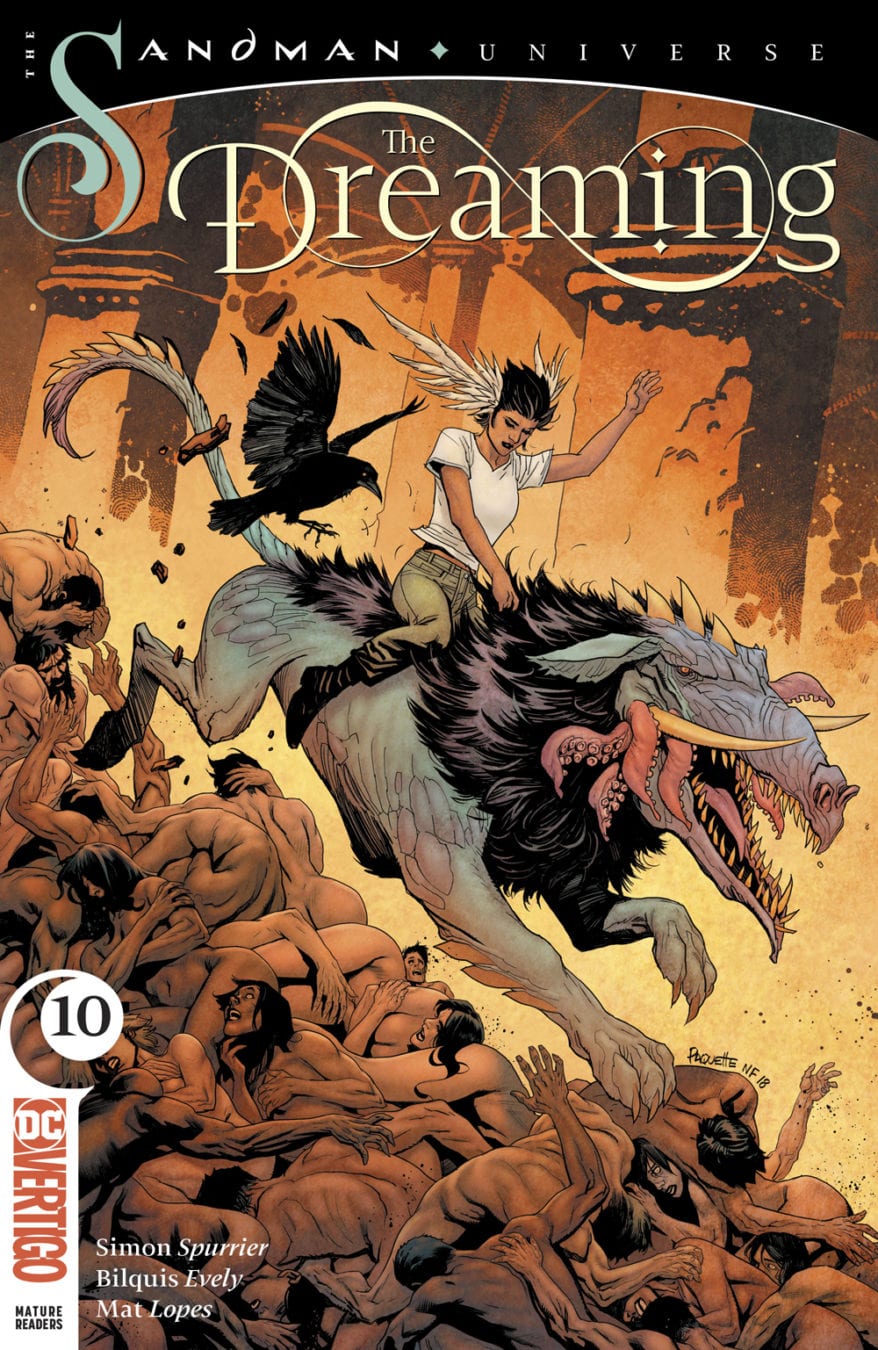Review: The Dreaming #10
 With rumors swirling around social media that the end of the Vertigo imprint, is immanent, reading contemporary Sandman Universe titles from DC comics feels more nostalgic than it should. As an imprint, Vertigo believed that sophisticated comic book readers existed and that mature, intellectually complex, stories had a place in the comic book industry. For the core fans of the Neil Gaiman, SANDMAN, Vertigo era of comics, DC“s THE DREAMING fully honors the spirit of Gaiman and Vertigo“s initial proposition.
With rumors swirling around social media that the end of the Vertigo imprint, is immanent, reading contemporary Sandman Universe titles from DC comics feels more nostalgic than it should. As an imprint, Vertigo believed that sophisticated comic book readers existed and that mature, intellectually complex, stories had a place in the comic book industry. For the core fans of the Neil Gaiman, SANDMAN, Vertigo era of comics, DC“s THE DREAMING fully honors the spirit of Gaiman and Vertigo“s initial proposition.
Written by Simon Spurrier and elegantly illustrated by Bilquis Evely, THE DREAMING #10, “Empty Shells,”“ tells a multi-layered intertextual tale that somehow encapsulates the best (and the worst) of the Sandman universe. Intertextuality ”“ the presence, citation, allusion, etc. — of one text in/into another ”“ is an essential literary feature of the Sandman narratology. In “Empty Shells”“ Abel has an ongoing dialogue with the interim ruler of the Dreaming. Abel (biblical brother of Cain) is alive in this narrative and it is Cain who may be dead ”“ an important allusion in THE DREAMING with an inverse relationship to its biblical referent.
As the characters discuss the relationship between stories/narrative and chaos, a panel depicts a number of library volumes floating around the library in disarray. Readers won“t make out the titles of most of these books but one is legible ”“ “Waiting Room of the World.”“ This is a literal depiction of intertextuality ”“ the image of a book within another book ”“ or in this case an image of a book within a comic book. But the book in question is actually an allusion to a quote often attributed to C.S. Lewis.
In the film, “Shadowlands”“ ”“ starring Anthony Hopkins as Lewis, he laments the indeterminable seasonal period between winter and spring: “Frosty mornings gone. Sunny mornings yet to come.”“ He refers to this liminal season as a “waiting room of the world.”“ The floating book allusion to it here in “Empty Shells”“/THE DREAMING summons C.S. Lewis, his timeless work that often hinges on traversing worlds, time, and space, and the ways in which THE DREAMING relies on similar themes and literary devices to organize its own unique narrative.
And that“s just one small bit of intertextuality in one of two interconnected stories in “Empty Shells.”“ Abel and the interim master of the Dreaming are following the story of Dora and Matthew (the raven) who are tracking “Sandman”“ ”“ also known as Dream (of the Endless) –across the nether realm/dimension. In “Empty Shells”“ they follow his trail to an archetypal mythic/religious figure whose presence in almost every narrative of civilization takes them (and the reader) through a labyrinthine mythological journey. Si Spurrier and Bilquis Evely depict the story vividly and with a mythological imagination commensurate with the infinite depth of the Sandman universe.
Allusion after allusion abounds in “Empty Shells”“ and in much of the contemporary titles in the Sandman Universe. The only question is ”“ and maybe the only drawback to this issue ”“ is there such a thing as too much intertextuality? Is it possible to reach a saturation point when it comes to literary or mythological references? We don“t know the answers to this yet, but THE DREAMING and the Sandman Universe are pushing the boundaries and posing these queries with astounding results in each issue. 4/5!
[yasr_overall_rating size=”large”]
(W) Simon Spurrier (A) Bilquis Evely (CA) Yanick Paquette
Author Profile
Latest entries
 Comic BooksFebruary 27, 2020Review: Fax From Sarajevo: A Story of Survival
Comic BooksFebruary 27, 2020Review: Fax From Sarajevo: A Story of Survival Comic BooksFebruary 13, 2020Review: BOX OF BONES #1
Comic BooksFebruary 13, 2020Review: BOX OF BONES #1 Comic BooksJanuary 16, 2020Review: HEARTTHROB Season Three #1
Comic BooksJanuary 16, 2020Review: HEARTTHROB Season Three #1 Comic BooksJanuary 8, 2020Review: EXCALIBUR #5
Comic BooksJanuary 8, 2020Review: EXCALIBUR #5





